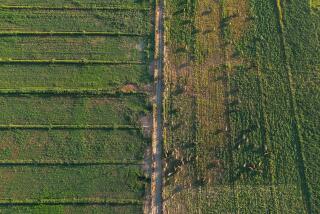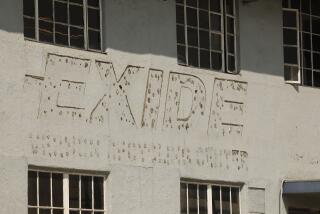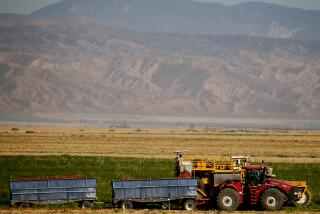Stench of Mammoth Hog Operation Divides Farming Community
- Share via
MILFORD, Utah — For three generations, the Mayer family raised alfalfa in emerald fields south of town, and sunrise used to bring only the promise of another satisfying day of hard work.
Now, however, dawn’s first breeze usually bears the eye-searing stench of tens of millions of gallons of hog waste. The stink rouses sleepers, who stagger to slam windows or flee to the basement. “I’ve gagged in my own home,” says Allen Mayer.
But to the Mayers and 50 other farm families, the fermenting waste in hog sewage lagoons isn’t the only thing that stinks about their newest neighbor, Circle Four Farms, the country’s largest hog-farming operation.
Circle Four, a joint venture by four of the East Coast’s largest hog producers, is setting neighbor against neighbor, its foes contend, by lying, corrupting local politics, fouling the air and threatening the semi-arid Utah desert’s scarce water.
In short, they say, the consortium of Smithfield Foods, Murphy Family Farms, Carroll’s Foods and Prestage Farms is employing the same political tactics and environmentally questionable mass-production techniques that caused North Carolina in August to slap a moratorium on corporate hog farming, encompassing operations of all four hog producers.
“It’s like the devil came to Milford,” says Joey Leko, whose Green Diamond Ranch lies up the lane from the Mayer clan. “This has split this community right down the middle, so’s one half won’t even talk to the other.”
But Circle Four Farms is just getting started in Milford, a town of 1,164 about 170 miles south of Salt Lake City. By the end of the decade, Circle Four wants its 600,000-hog-a-year Milford operation to anchor a 25-mile string of farms, quadrupling its annual yield to almost 2.5 million hogs.
“This is on a scale that has never been visited before,” said Nancy Thompson of the Center for Rural Affairs in Walthill, Neb., which studies and monitors the effects of corporate farming. “There is nothing to compare it to.”
Four years ago, when ground was broken, locals called Circle Four an answer to prayers, and many still feel that way. Mining and the railroad were dead or declining and the city hadn’t issued a building permit in 16 years.
Today, more than 60 homes and other buildings are under construction. Circle Four is the county’s largest employer, with 300 jobs and a payroll exceeding $6 million.
“They’ve been a godsend,” said Mayor Mary Wiseman, whose living room foyer features a life-size plaster hog. “This town was dying.”
Patty Cherry, a waitress at the all-night Hong Kong Cafe, says three of her daughters and their husbands work on the farms. A fourth daughter was just hired and is moving home.
“My family is together because of that farm,” she said. “It seems to me that’s a fair trade for a little smell.”
That “little smell,” most often in the early mornings and late evenings, can roll into town like a putrid fog, clinging to clothes and sticking in the backs of throats.
Even Wiseman and other unabashed fans of the farm say Circle Four’s assurances that the odor would be manageable have proved false.
Reported plans to cover the lagoons never materialized. Today, each of about 80 open-air lagoons holds 6 million to 27 million gallons of waste. Solid waste is allowed to settle in a primary pond, where bacteria break it down. Liquid drains into a second lagoon for evaporation.
Considering that hogs generate two to three times as muchwaste as humans, Circle Four’s current operation produces the yearly equivalent waste of 1.8 million people--just shy of Utah’s 2 million population.
“That’s a lot of hog crap, any way you cut it,” says rancher Leko. “Look, we’re farmers. We can put up with animal odors. We can’t put up with a sewer in our homes.”
Circle Four developmental director Rob Adams says the company has encountered unexpected problems. For one, Utah’s cool, dry climate was expected to hold down the odor. Instead, it has slowed growth of the bacteria that break down the waste.
But Circle Four also hedged its bets. In 1994, Circle Four lawyer Warren Peterson drafted--and the state Legislature passed--the Utah Agricultural Protection Act. Among other things, it prevents lawsuits against agribusinesses over such things as odors.
The act must be implemented on a county-by-county basis, however, and the Beaver County commission balked after howls of protests from residents.
Circle Four’s influence is just as powerful close to home. Two Beaver County commissioners have significant business dealings with Circle Four and, for a time, the farms’ former development director was both a Milford councilman and a member of the county planning and zoning commission, which regulated Circle Four’s expansion.
Opponents also worry that Circle Four’s operations will deplete or contaminate the deep underground aquifer that feeds area wells. They view with alarm its wholesale purchase of water rights.
Circle Four, they say, showed its colors last year by failing for 44 days to report an accident in which as much as 80,000 gallons of hog waste were siphoned into a well. The company was fined $6,800.
The state requires the lagoons to be lined with plastic or clay and has ordered monitoring wells, but concedes Circle Four does its own testing. The state takes samples from the wells once a year.
Farm critics want more.
“Government should be involved more frequently,” says Tom Bryson, who lives in neighboring Iron County, where Circle Four plans its next hog farm.
“This is kind of like letting the fox guard the henhouse,” he says, “although, in this case, it’s the outhouse.”
More to Read
Sign up for Essential California
The most important California stories and recommendations in your inbox every morning.
You may occasionally receive promotional content from the Los Angeles Times.










